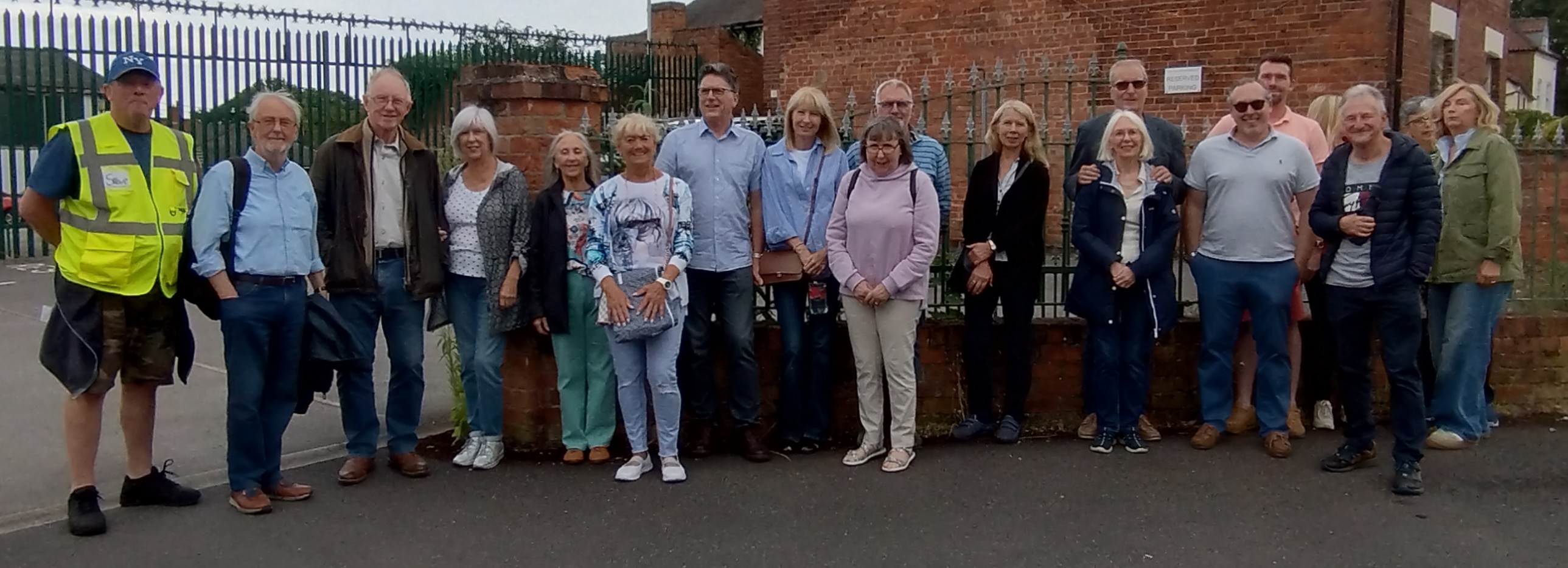Evening Trip to Bawtry
Following our first evening visit last year to Southwell, 20 members and friends visited the town of Bawtry. We were fortunate to have a knowledgeable local guide, Steve Kimber, an executive member of Doncaster Civic Trust.
From our meeting place at the north end of the Market Place, we first went up to Top Street. Steve, an enthusiastic advocate of ‘what the Roman’s did for us’, told us about the early history of Bawtry as an important location on the Roman road from Lincoln to Doncaster. Top Street was originally Roman, the first main road in Bawtry, pre-dating the current main road through the Market Place.
We then walked south to see the grounds of Bawtry Hall and learned about its early ownership by a Hull merchant. His business involved transporting lead from Derbyshire mines and other products from the area to Bawtry wharf. They were transported by barges to West Stockwith and then by the Trent to Hull for export. Steve also told us about the hall’s later life as an important RAF command centre.
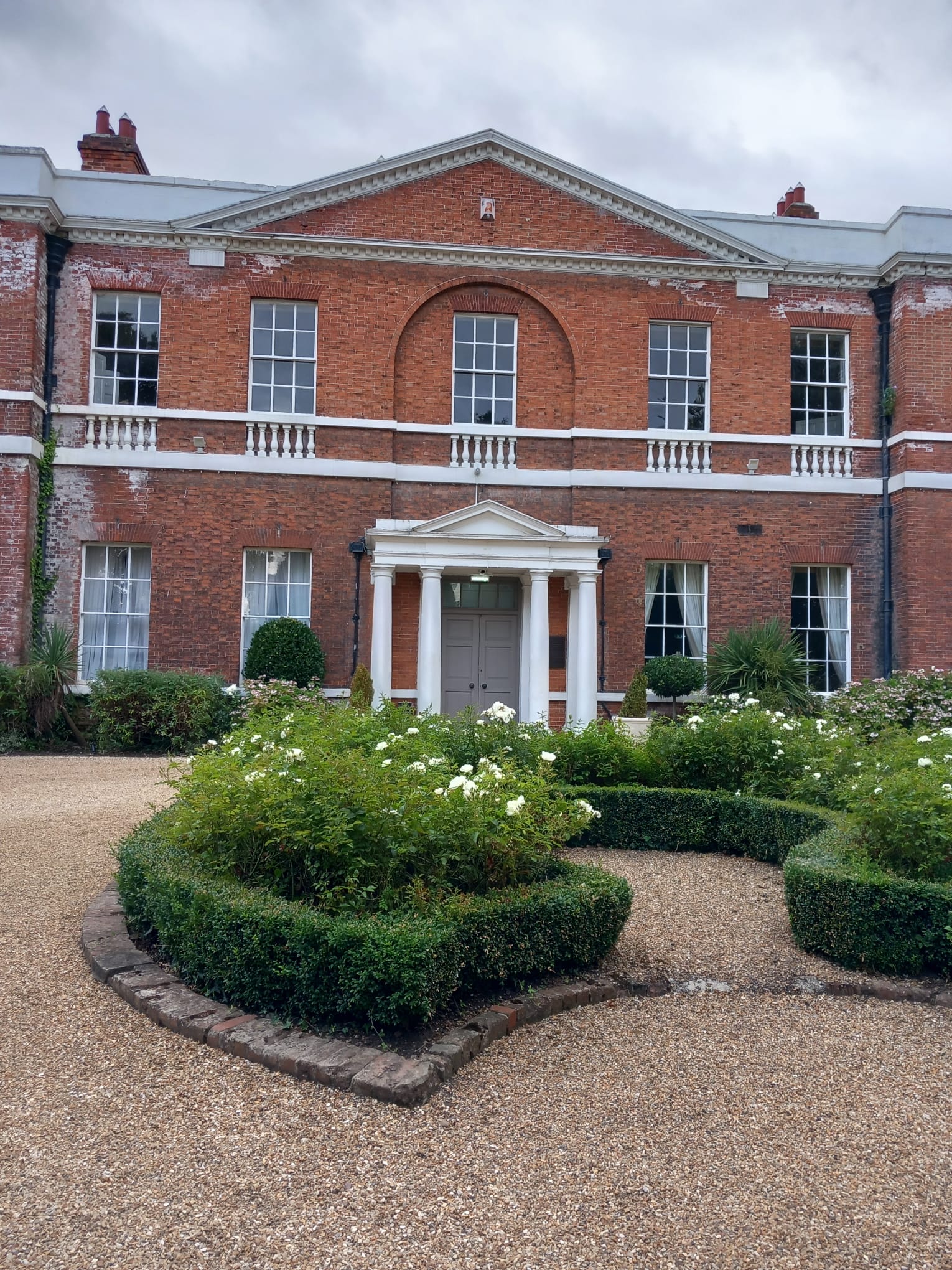
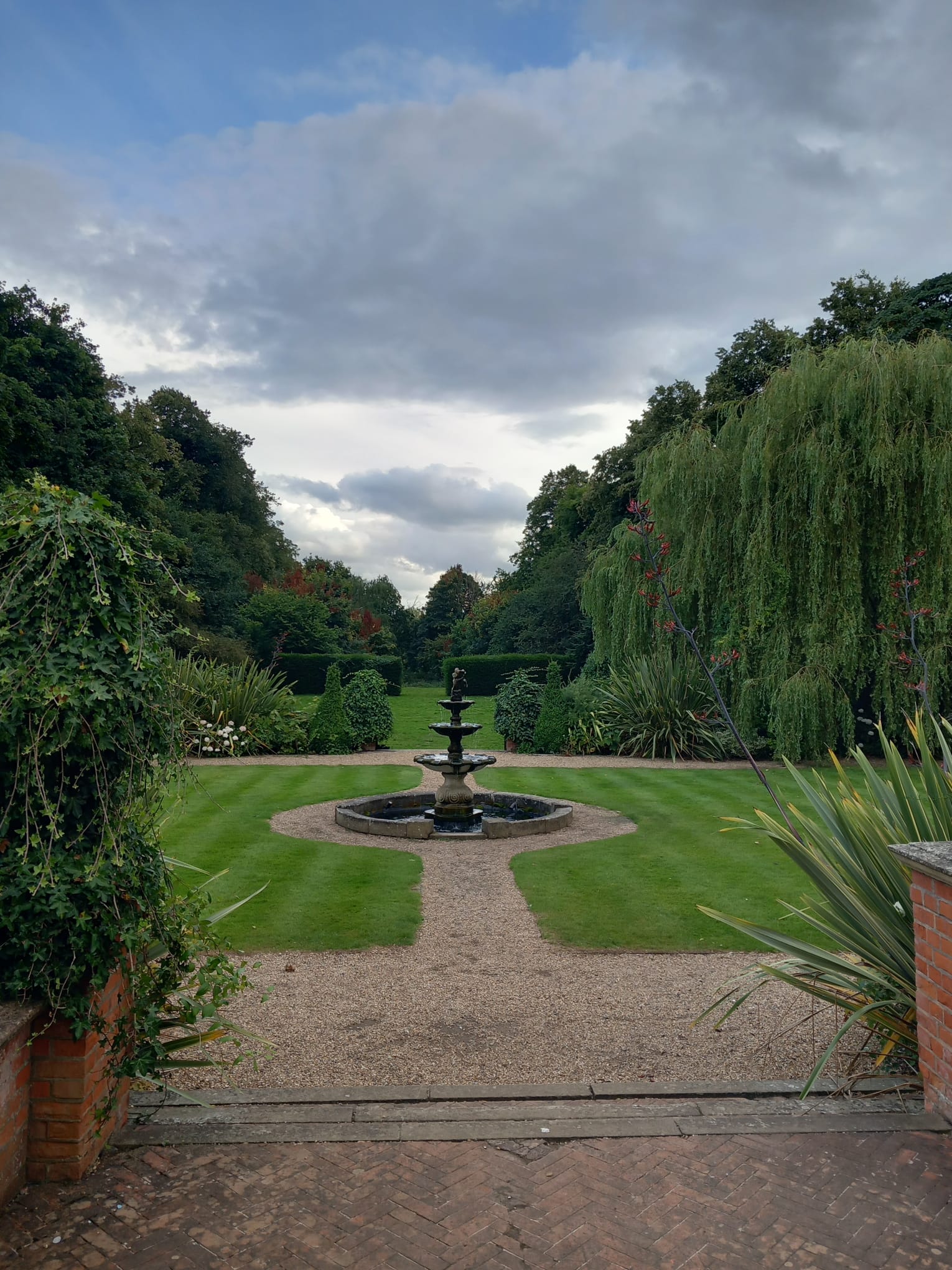
Crossing over to the east side of the Market Place we learned about the importance of Bawtry as a coaching stop, with many inns, the last remaining one being the Crown Hotel. The main era of the coaching days lasted only for about 50 years, until the advent of the railways. However, since the first railways travelled only north-south, an important business for The Crown continued as a posting house, where mail was delivered by rail, to be then distributed to the east and west by coaches.
The old Town Hall in the Market Place dates from 1890 as we could see!
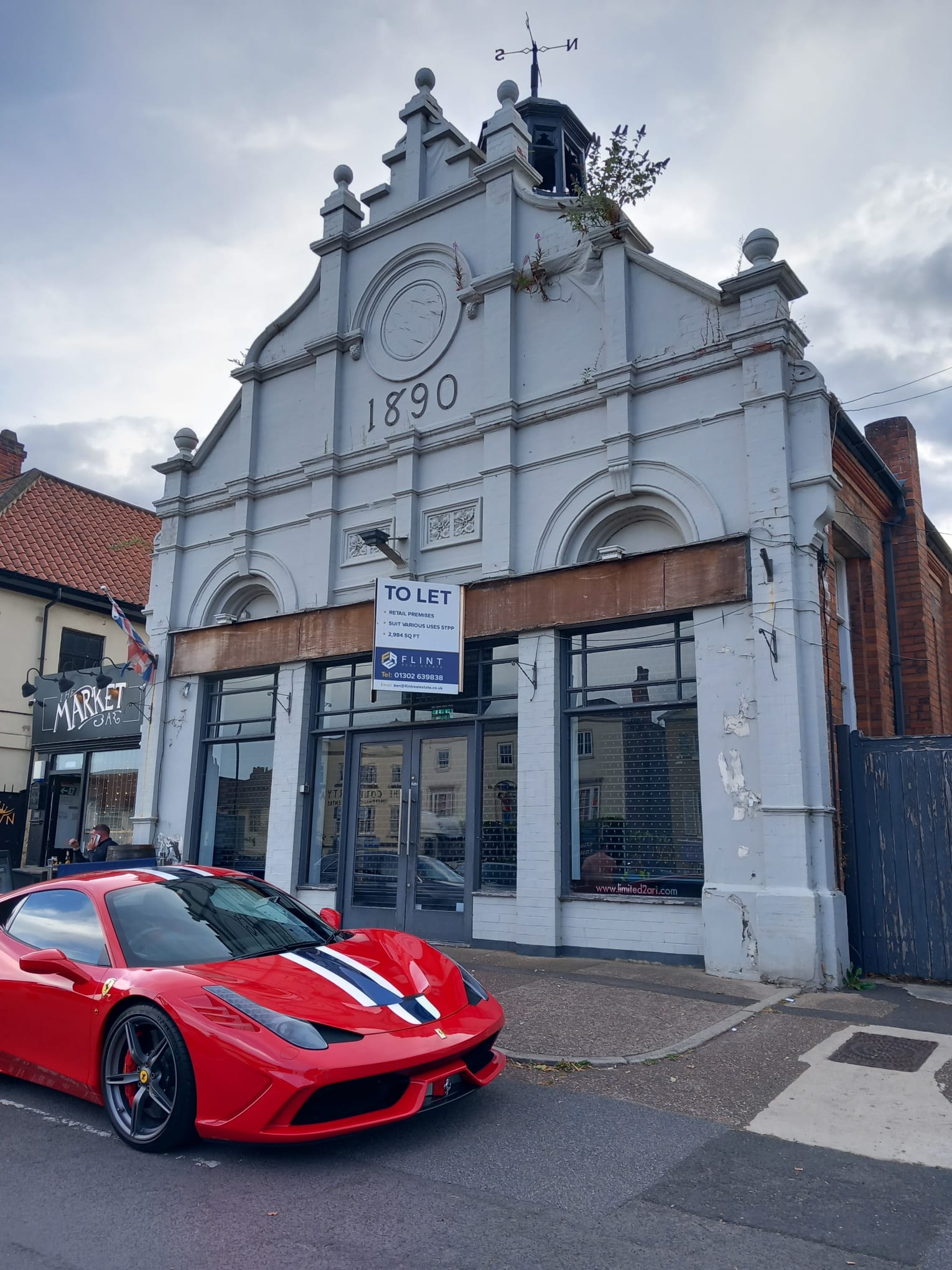
Once the Town Hall
What is now 'The Tasting Note' was once thought to be a small workhouse and according to archive papers at the time of inspection in 1835 there were 10 residents - 4 men, 3 women and 3 boys. There is a cross at the apex of the roof and it is believed the building was once known as Cross House.
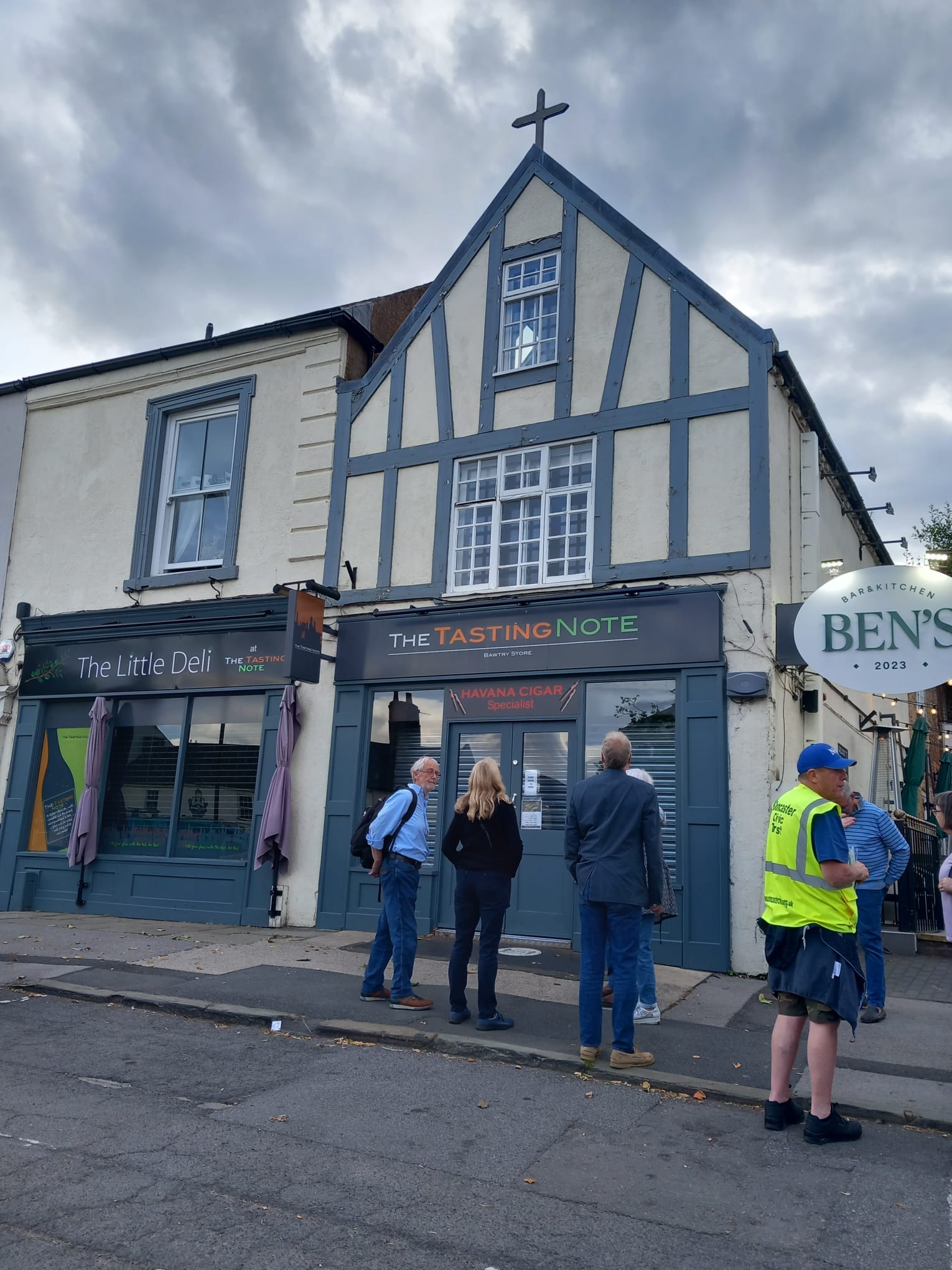
Once the Bawtry Workshouse
It was fascinating to learn that the site of the Co-op store was formerly the Angel Inn, one of the largest and busiest inns. Walking down Swan Street we entered the The Courtyard shopping centre, the cobbled stones of which formed the Angel Inn’s yard.
We walked north and were shown the differences in the local architecture of the Market Place buildings and turned right down Wharf Street past St Nicholas’ Church (St Nicholas is the patron saint of seafarers) to the end of the track. The location of Bawtry’s 12th century wharf had been a mystery to many of us. We were surprised, when standing opposite the railway viaduct, when Steve told us we were standing on the original course of the river Idle. This was the position of the wharf. Steve explained that when the viaduct was built the land next to the river was not stable enough. So the river was moved 300 yards to the east. Mystery solved!
Our trip was very enjoyable. It was a lovely evening for a walk and we all learnt a great deal about the history of the town. Many Thanks to Steve and Doncaster Civil Trust for arranging our visit.
Trip to Old Sheffield
25 July 2024.
Our group of 16 left Gringley at 09.00 travelling as usual with our driver, Scott, from Unity Tours. Although our booking was for the 16 seater minibus, to our delight Scott decided to collect us in his new 60 seater Mercedes bus. A great start to our day!
At 10.00 we arrived at Sheffield Manor Lodge. It was a lovely day and the wildflowers from the Green Estate set the scene perfectly. The lodge was built in the 16th century on the site of an earlier 14th century lodge. The remains of the Tudor buildings included one of the first long galleries in the country and the, now ruined, tower where Cardinal Wolsey stayed for 18 days before travelling on to Leicester where he died of dysentery. The outstanding building is the Turret House (seen below), renovated in the original Tudor style which would be recognised by Mary Queen of Scots who was ‘imprisoned’ at Sheffield Castle and the Manor Lodge for 14 years.
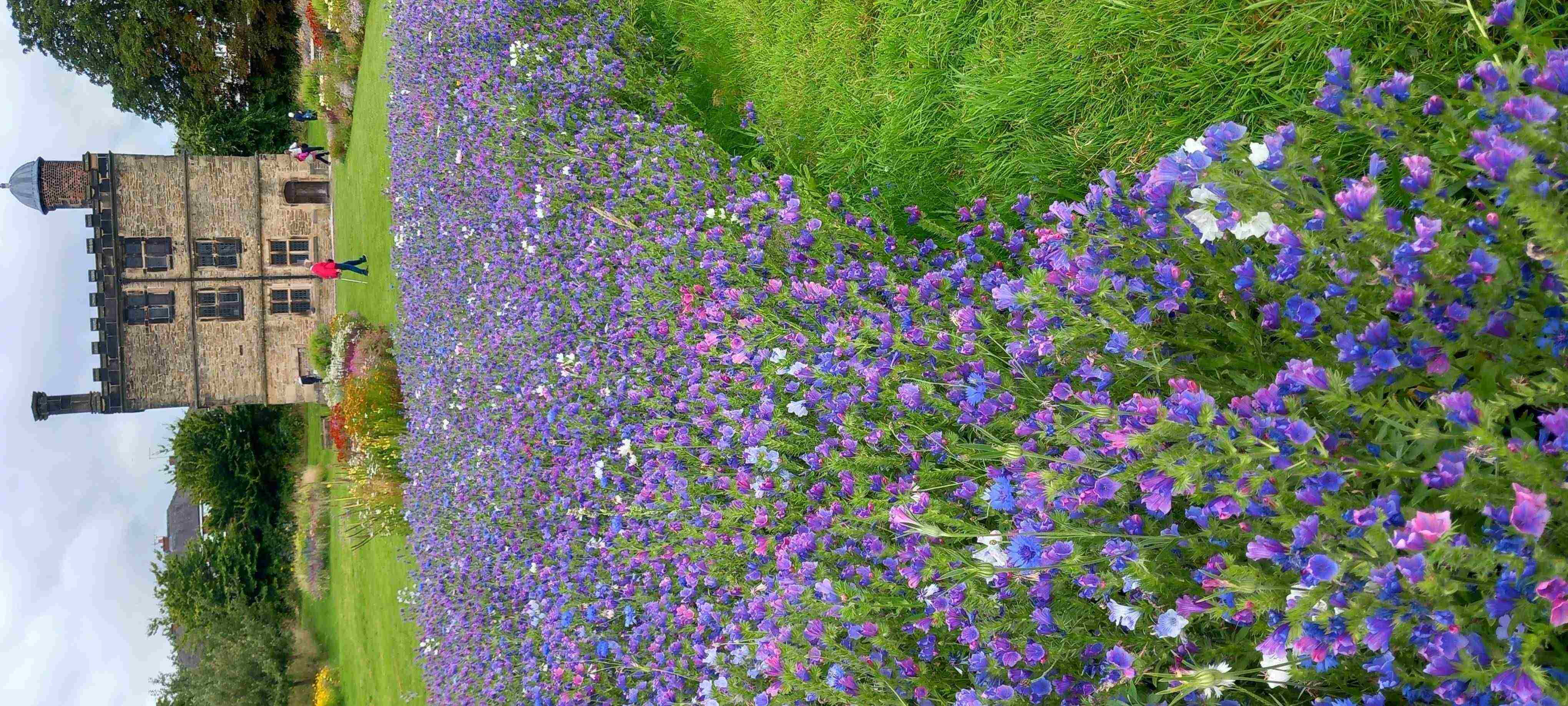
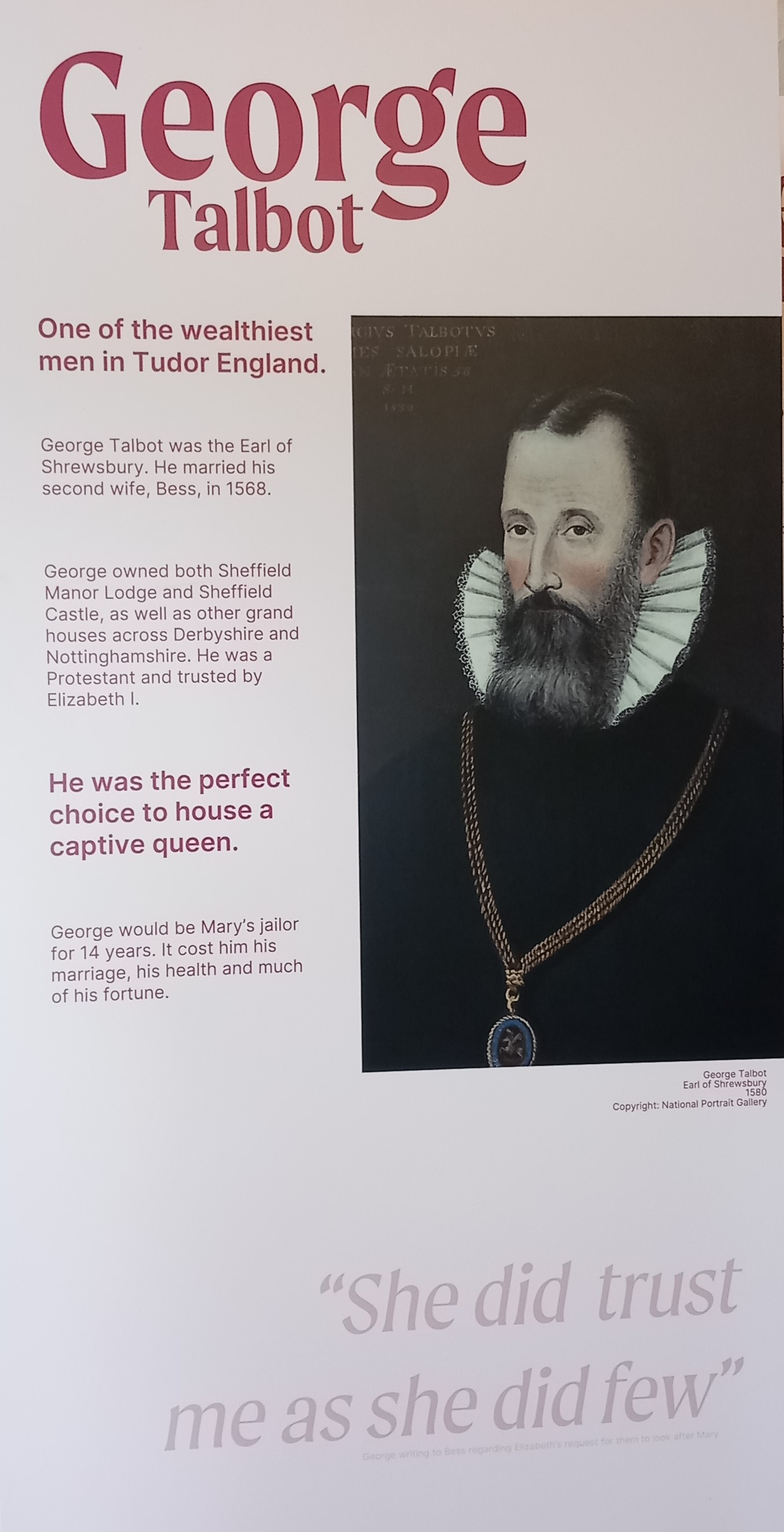

Inside Turret House

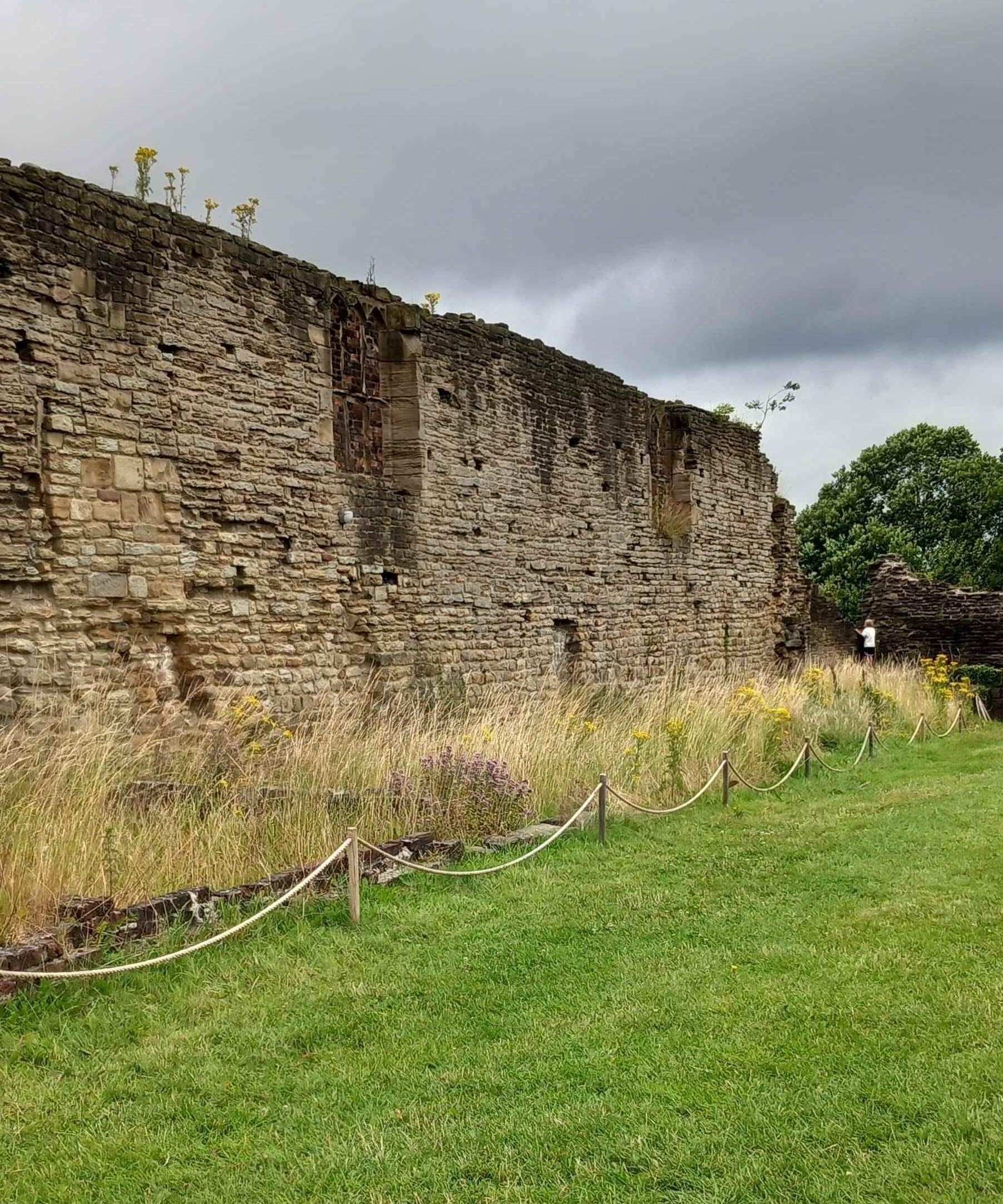
The Long Gallery
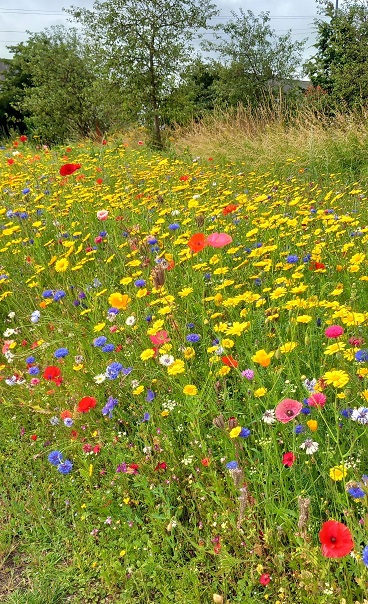
After tea/coffee we moved into the old industrial centre of Sheffield to Kelham Island Industrial Museum. Set on an island in the middle of the river Don, it has an incredible display of every type of steel products originating in the city. Our visit was timed to include a demonstration of the River Don rolling mill engine, an amazing experience of sight and sound.
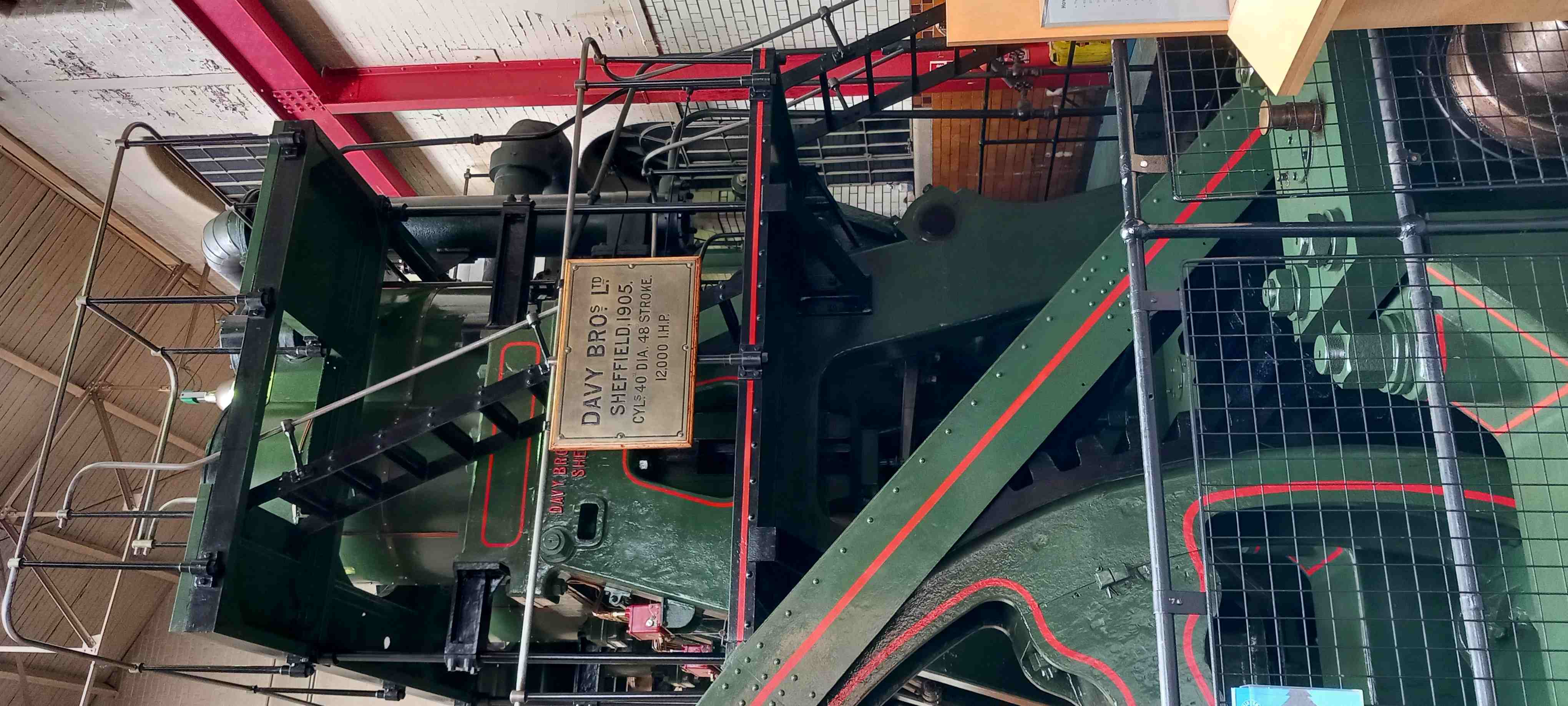
After lunch at Kelham Island we finished our trip with a guided tour of Sheffield Cathedral. Originally built around 1200, it is the oldest building still in use in Sheffield. We were shown the many changes which have been made since then up to the most recent, modern extension. There was lots of history of the former Lords of Sheffield, the Talbot/Shrewsbury lordship. The modern café provided a welcome period of calm before we were met by Scott for our return to Gringley.
We all knew something about Sheffield before the trip but everyone was delighted by the extent of the new information and activities we experienced. Many Thanks to Brian for spending his time organising a very interesting itinerary.
Gringley History Club 2022-3
Annual Accounts 01/11/2022 to 31/10/2023
Starting fund £ 6426.69
1) Capital account
Income
+£102.99 Book sales
+ £102.99 = Total in
Less Expenditure
£ 150.00 Tribute boards
£ 60.00 Grave Project website costs
£ 29.98 Grave project sundries
£ 150.00 Village map repair
£ 61.82 Printing Deep Pockets books
£ 16.25 Replacement keys CC cabinets
- £468.05 = Total out
Resulting in - £365.06 from fund
2) Club profit/loss
Income
£ 405.00 Memberships
£ 18.10 Donated
£ 81.00 Meeting income
+£504.10 = Total in
Less expenditure
£ 268.99 Website costs
£ 70.56 Insurance
£ 205.00 Meeting costs
£ 15.30 Notts trip
- £559.85 = Total out.
Resulting in -£55.75 from fund
————————————————————————————————————————————————————
3) Overall Accounts
Started with £6426.69
Less £365.06 capital
Less £ 55.75 club
Total spent = -£420.81
carried forward to 2023-24 = £6005.88
Represented by:
Balance at Barclays Bank 31/10/2023 £5955 88
Cash held by SOH 31/10/2023 £50.00
Total carried forward = £6005.88
I certify that I Susan O’Horan have in my possession the sum of £50.00
Signed ……………………………… Date …………………
Accounts checked by M. Garrett ……………………………… Date ………………
Accounts checked by P. Hamer ……………………………….. Date ……………….
Trip to the Caves, Tunnels and Castle of Nottingham
3rd October 2023
Our group of ten travelled to Nottingham on the Robin Hood Line from Worksop station, an excellent way to travel to Nottingham centre. A short walk took us to the City of Caves, near the site of the former Broadmarsh Shopping Centre.
The earliest inhabitants in the area chose to settle on the massive sandstone outcrop, now the city centre. The soft stone allowed caves and tunnels, up to 800 of them, to be created, initially using rudimentary tools. Our guide led us down to an extraordinary cave network where people had once lived and worked in industries such as tanning, and brewing. For centuries the caves have provided a perfect storage area for ale.

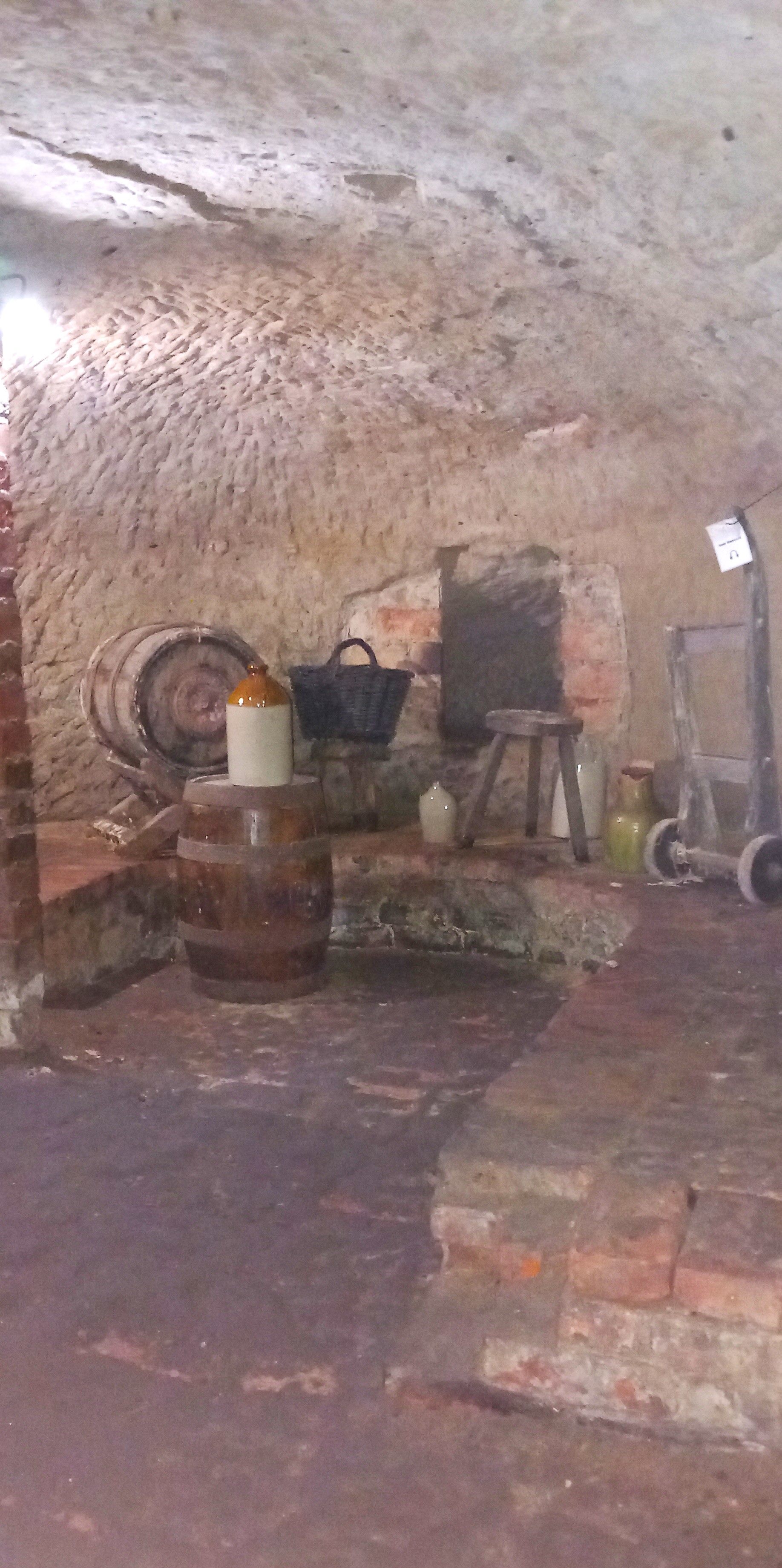

Families were living in the caves until 1845
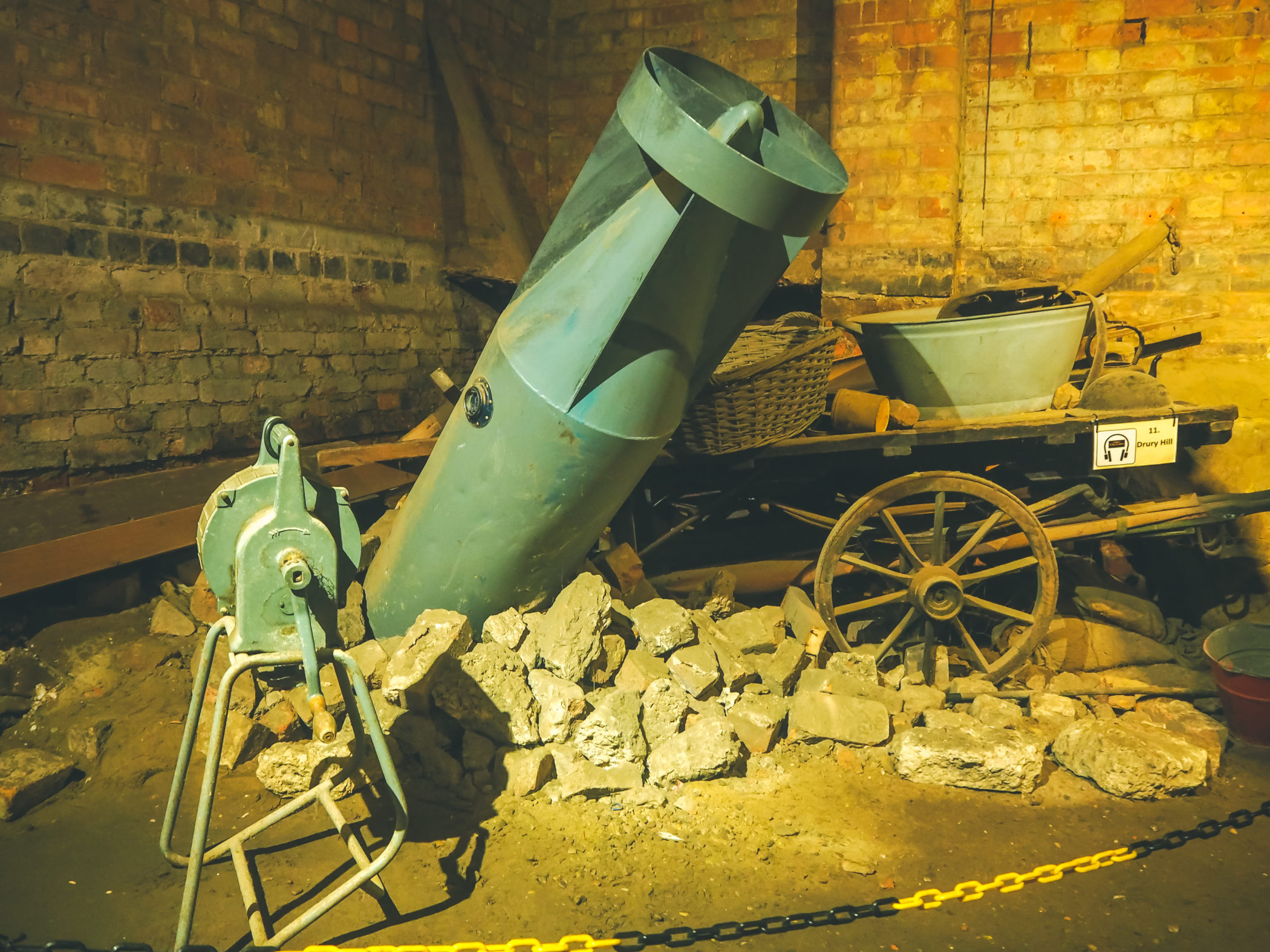
Moving ahead in time we found ourselves walking through air-raid shelters used during WW2.
After coffee in the café of the Nottingham Contemporary Art Centre we made our way up to the Saxon market square with its market cross (a lot newer than our village cross).
Our route to the Norman castle took us along High, Middle and Low Pavements, passing many of the city’s finest buildings including Willoughby House, now the hub of the Paul Smith fashion group.
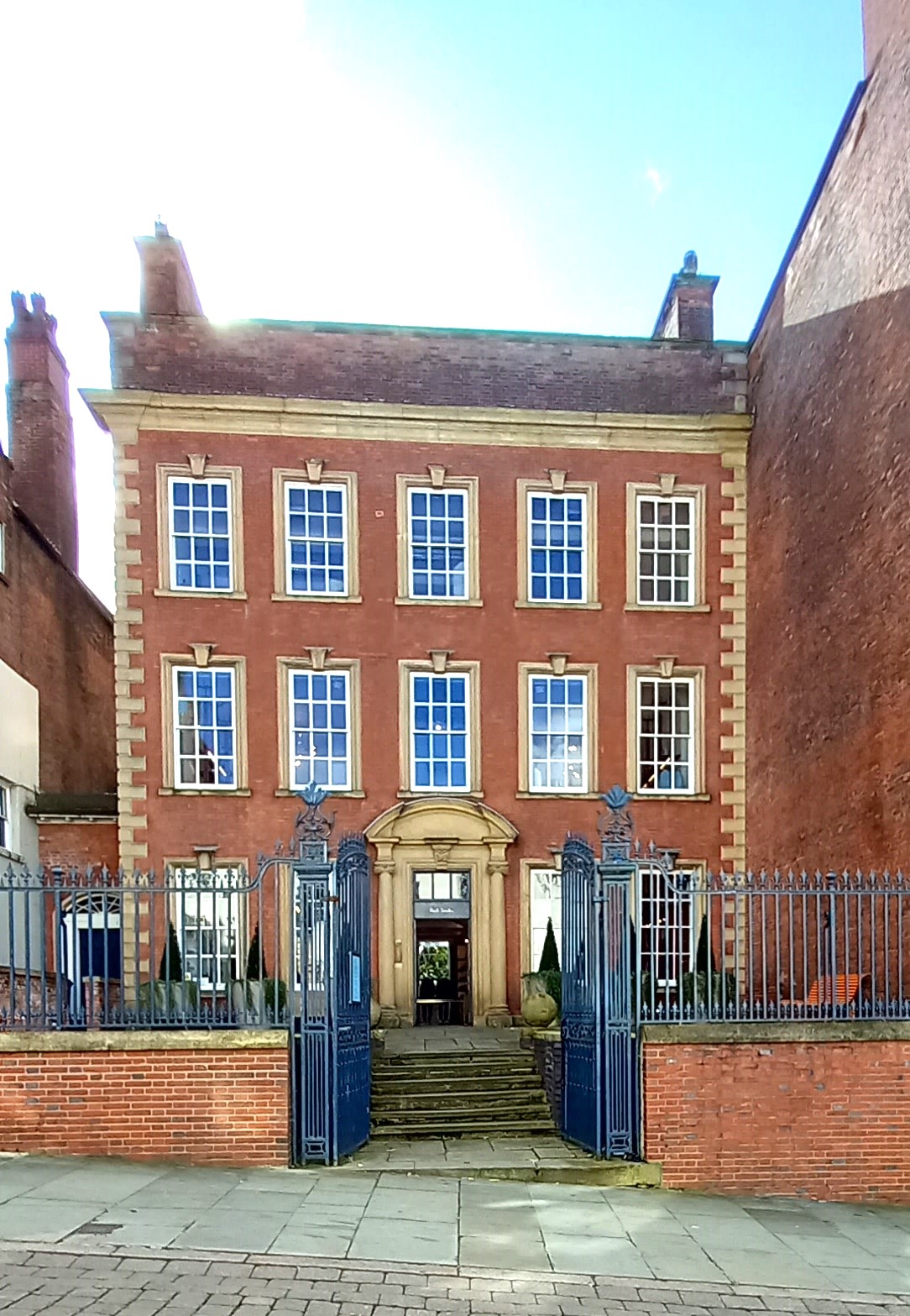
Willoughby House on Low Pavement, Paul Smith Fashion House
As well as all things ancient Nottingham also embraces the modern!

We stopped at Newdigate House to look at the blue plaque for the French General Tallard, who during his stay there as a prisoner of war in1705, introduced celery into the English diet. Life in Gringley would have been very different without his initiative. To find out more about celery in Gringley, follow this link

Newdigate House Blue Plaque
"In this House lived Marshall Tallart from 1705 to 1711.
While prisoner of War after The Battle of Blenheim 1704"
Newdigate House is currently home to the Nottingham Club. The World Service Restaurant moved into the premises in 2000.
We left Newdigate House and walked onwards to Nottingham Castle which fittingly stands on Castle Rock, another large sandstone outcrop. Following its destruction after the Civil war it was re-built as a pleasure palace by the 1st and 2nd Dukes of Newcastle from Welbeck Abbey. It is now Nottingham’s main museum, with lovely grounds.
We stopped for lunch in the Terrace Café, where as well as having a good lunch, we enjoyed stunning views of the city.
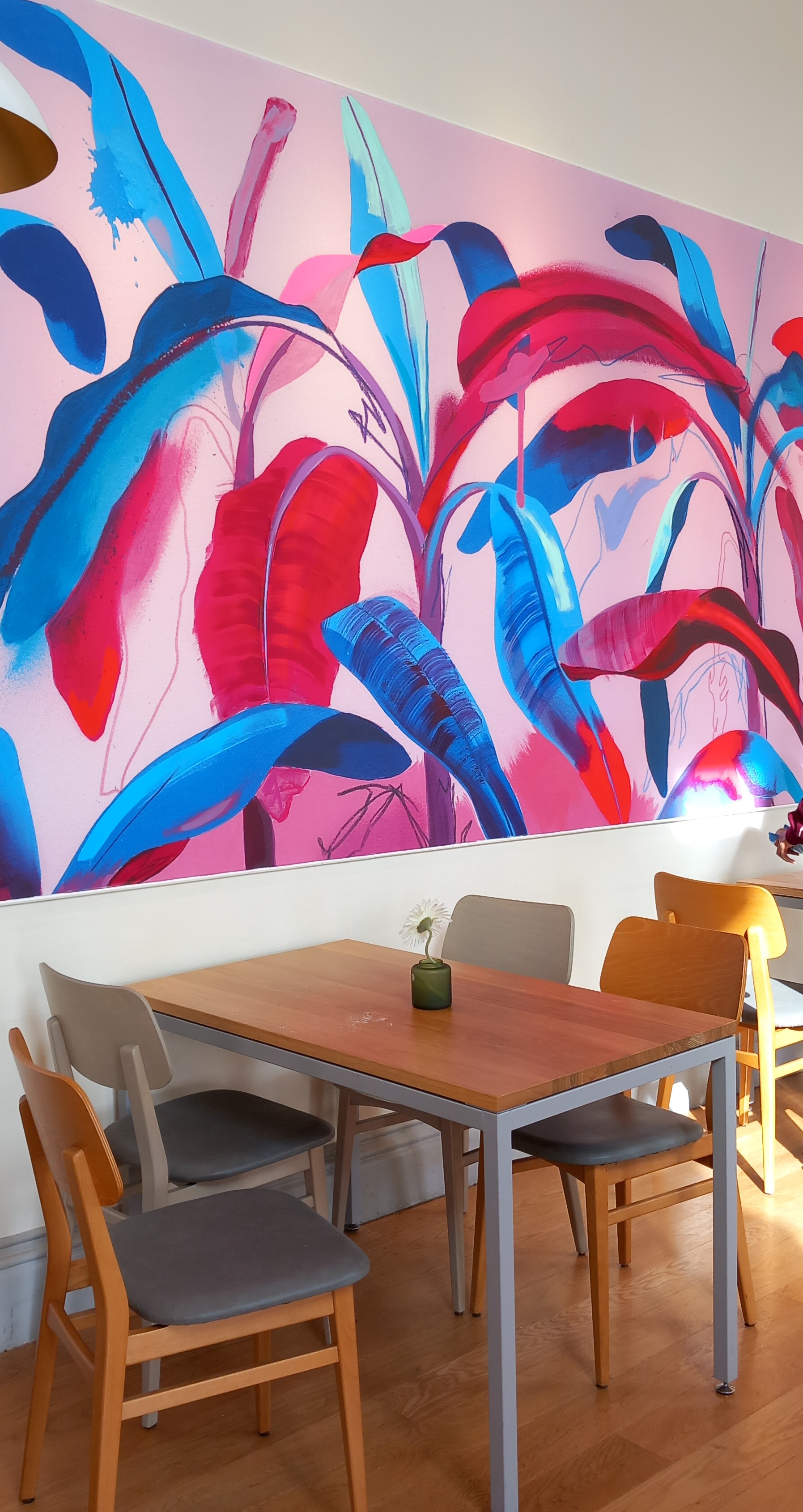
The Terrace Cafe
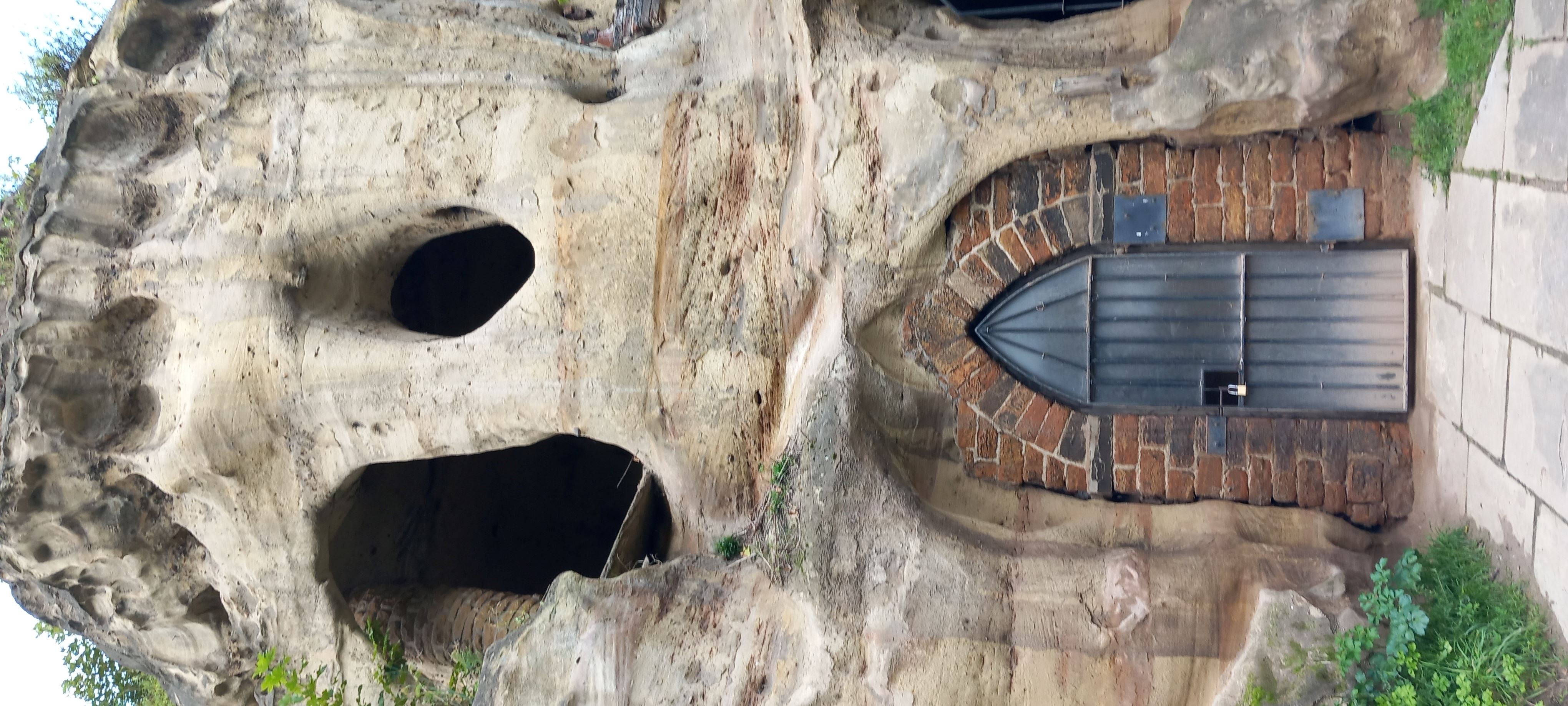
Next on our list was Mortimer's Hole. Our guide Barry took us deep into Mortimer’s Hole, a massive tunnel leading from the castle to the foot of the outcrop. We learned about the young Edward III who used the tunnel to enter the castle, depose the Pretender Edward Mortimer and claim his rightful crown. Barry entertained us wonderfully with stories of the history of Nottingham and its importance as the traditional boundary between the North and South of England.
Very conveniently, at the base of the Castle Rock we found ourselves at the Trip to Jerusalem, one of England’s oldest inns. Its own interesting history, built inside the rock, was equalled by its excellent range of real ales. It was a difficult place to leave, but we had to make our way back, via Nottingham Canal Basin, to the station and our train back to Worksop.
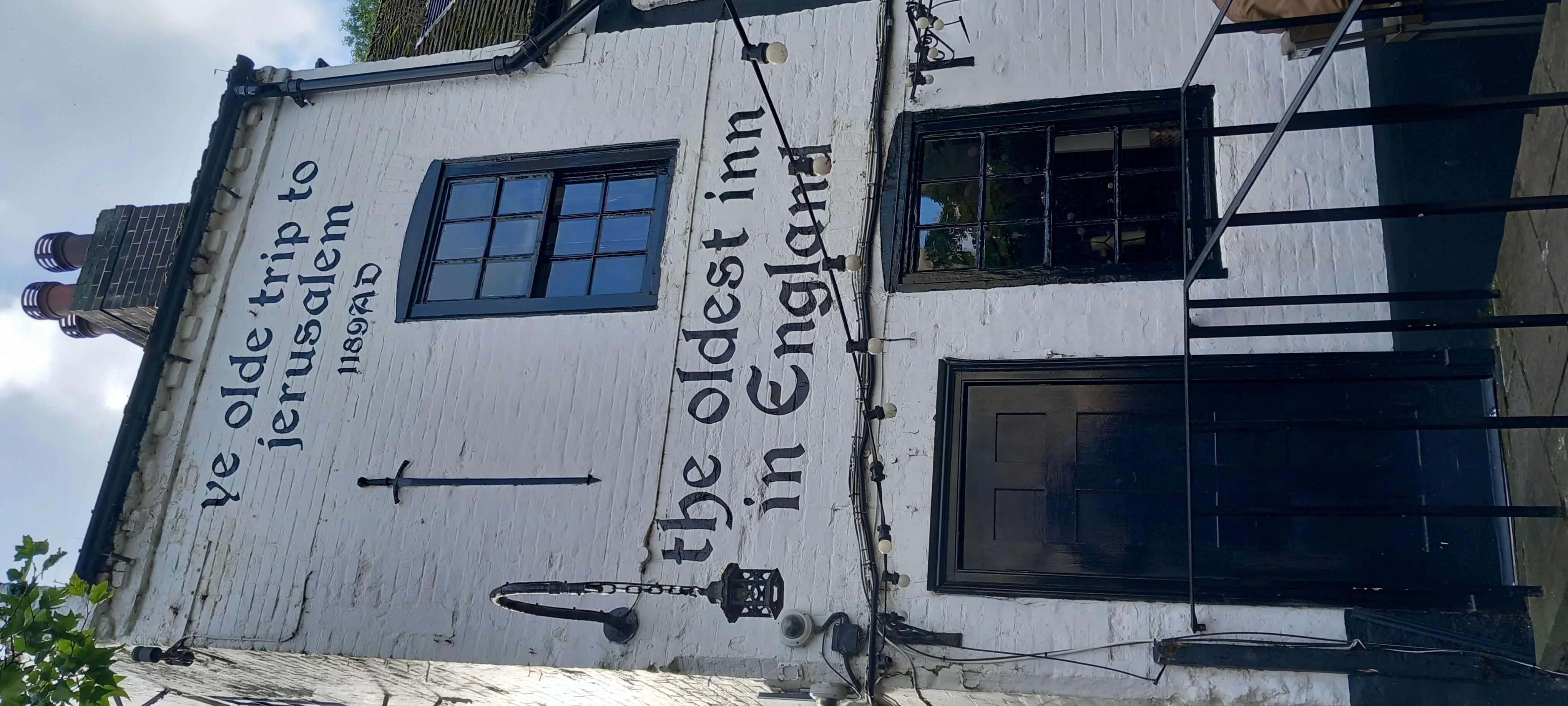
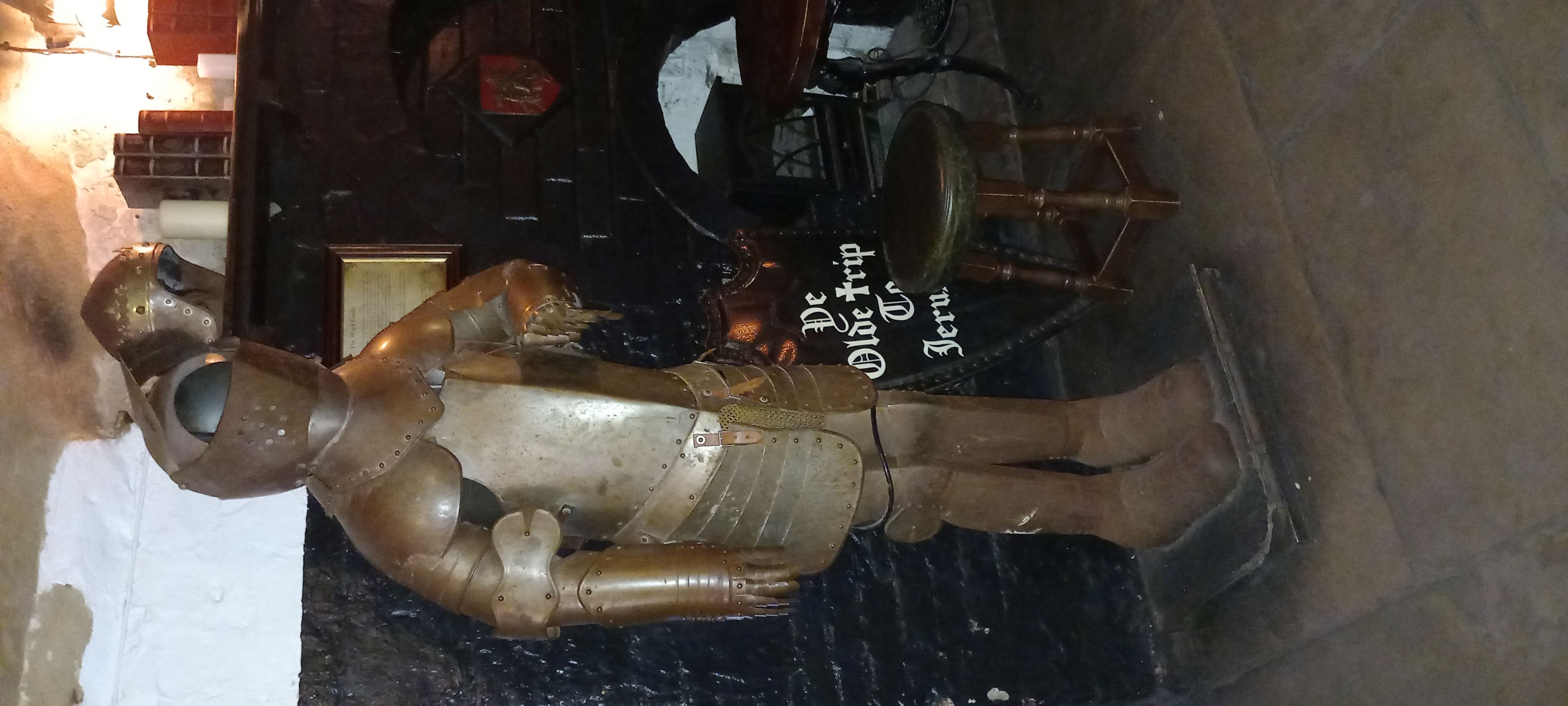
We had a lovely trip. Many thanks to Sue for stepping in at the last minute and doing an excellent ‘Blue Badge’ role.
GRINGLEY HISTORY CLUB
AGM: Monday 17 January 2024: Community Centre
MINUTES
PRESENT
Committee: Mike Garrett, Pamela Hamer, Kathy McIlroy, Brian Hansen, Adrian Griffiths, Sue O’Horan.
Apologies: Sharon Keeble.
Members: Brian Shepherd, John Brough, Michael Hebblewhite, Joan Soulsby, Ian Soulsby.
Apologies: Roy & Kate Evans.
Mike Garrett opened the meeting.
Minutes of AGM held 20 February 2023.
Minutes had been sent to all members prior to the meeting.
There were no comments on the minutes.
Reports
The meeting heard reports from Mike Garrett (Chairman), Sue O’Horan (Treasurer), Pamela Hamer (Secretary).
Chairman’s Report
I’m very pleased to report that we were able to have a complete programme of events for the first time in a few years.
We had five speaker events. In January Adrian Griffiths told us the first part of his history of the city of Coventry, from its origins to a thriving medieval town and the truth about Lady Godiva. In March Tim Mulroy told us the story of his father and aunt who came to England in 1939 as part of the kinder transports from Prague. In May Maggy Watkins told us the second part of the of the Pilgrim Fathers’ story, including their horrendous journey to America.
After our summer break our October talk was also about a journey, this time much more sedate, taking the ‘Slow Road’ around England on canals with Mike Ogden. Roy Evans gave our final talk in November with a comprehensive history of Lincolnshire airfields during WW2 and their use today.
In February, our AGM was followed by a very interesting presentation by Stuart Cattell about his experiences in metal detecting. We also had informal club nights in the Blue Bell in April and June.
In August, for the first time we arranged evening trips. We visited the beautiful town of Southwell with our guide, a member of the Southwell Local History Society. It was a lovely way to spend a warm summer evening. A total of 26 members took part in two trips. In October ten members went on a guided tour of the caves and tunnels of Old Nottingham. After travelling to Nottingham on the Robin Hood Line, they visited the City of Caves, Nottingham Castle and its tunnel, ending with refreshments at Ye Old Trip to Jerusalem.
We ended the year in December with our Christmas Social and Membership Night at the Blue Bell with Fizz & Nibbles. It was a busy, successful evening with the opportunity for memberships to be renewed for 2024.
After a delay of some years, we re-launched our project to survey all the burials in St Peter’s churchyard. Club members worked in all weathers to complete the project by our mid-year target. We examined every memorial in the churchyard, uncovering and cleaning where necessary, and recorded the inscriptions where possible. A total of 217 memorials were surveyed, and we identified 266 people, whose memorials can now easily be found. Our survey can be viewed in the church, in our club archive and on our website.
Our club has an extensive historical archive about Gringley and we present it to residents through exhibitions, talks and walking tours. This year we were also able to work with St Peter’s School, giving a presentation about the businesses which existed in the village and how the village has changed, followed by a tour for Class 1 pupils of relevant village sites.
In conclusion, 2023 was a successful year for our club. Such a full programme of activities can only be achieved by the commitment and efforts of our committee, and I would like to thank the committee for all their help.
Looking ahead to 2024 we have a full programme of speaker events, walks, trips and other activities. The seven members of our committee are keen to get involved with all aspects of history in Gringley, local areas and further afield. Please contact us if you have any areas of interest.
Treasurer’s Report
The Treasurer tabled the accounts for 2022/23, attached. Sue explained the new structure of the report, presenting the Capital Account and Club P&L separately, before being combined in the Overall Accounts.
The club has experienced an increase in fixed costs, mainly due to costs of website maintenance and insurance. Our website presence is important to the club and we are committed to maintain it. Efforts to improve margin in 2024 may include control of speakers’ fees, raffles and contributions towards refreshments at events. In 2025 we will consider increasing the membership fees.
Secretary’s Report
Following on from the Chairman’s report - all the talks were very well attended by both members and visitors.
- January: Coventry: Godiva to the Civil War: Members 30 – Visitors 3
- March: The British Schindler: Members 32 - Visitors 10
- May: Mayflower new beginnings: Members 22 – Visitors 7
- October: The Slow Road: Members 25 – Visitors 7
- November: Wings over Gainsborough Members 24 - Visitors 16
Over the 5 talks the average attendance was 35.
The secretary thanked Mike and Sharon for putting together the programme.
In 2023 we had 53 members, one more than the previous year.
At the Social and Membership night in December, those members who attended joined for 2024. So far this year we have 35 members, of which 34 are previous members and one new member.
Election of Officers
All the officers were prepared to stand for another year and as no-one else came forward to stand for these roles the current officers were all re-elected by those present.
Comments on reports/AOB
Membership: Discussion on membership numbers, i.e. how to attract more members. A leaflet about club activities could be included in Hugo’s package to new residents. Mike will contact Hugo.
Community Centre Open Day: Adrian is considering an Open Day in the CC to display all village activities. Agreed that we would like to be involved.
D Day 80th Anniversary – 6th June 2024: Kathy reported that the PC are planning to light the Beacon, possible village party and ‘Fish ‘n Chips’.
We discussed possible History Club activities. May include an event, similar to our ‘We’ll Meet Again’ party; a talk on Laycock? We will display our village boards around the village before 6 June. We will discuss in more detail at our committee meeting on 19 February. Kathy will advise the PC committee.
Open Gardens 2024: Club involvement will follow Hugo’s planning and subsequent request.
More Articles ...
Subcategories
News
THE GREAT GRINGLEY HISTORY SHOW 2020
The Community centre was busy on Sunday 8 March 2020 when Gringley History Club hosted 'The Great Gringley History Show' otherwise known as 'Where do You ThinkYou Are?' Dozens of visitors from the village and further afield came to take part in the History Club's open day. They were presented with a vast collection of documents, books, photos, displays, maps and other artefacts showing aspects of Gringley-on-the-Hill's history as far back as Roman times and even the Stone Age, with a quern stone excavated from Gringley 'Beach'. Visitors were able to learn about Gringley in the two world wars including details of some of the 24 casualties recorded on our war memorial. Crime and punishment was covered, including a publication of 'Gringley News', along with stories of convicts transported to Australia and a hanging in Nottingham Jail for murder. Ledgers showed Parish Council Records, burial reports (from Mr Hunter, Undertaker) and property records.
A fascinating new exhibition and display showed the history of Wiseton Cricket Club, along with photos and a unique blazer and cap in Laycock's colours (green & white), kindly lent by Adam Kay.
Many visitors engaged with club members to talk about their personal experiences. A welcome surprise was the visit of Stuart Sipson, who lives in Ordsall. He was a patient in the 1950's in theTB hospital formerly based in Gringley Hall. Stuart described his treatment, including being immobilised in a steel frame for up to two years, along with other anecdotes about hospital life. We were able to show him our book and exhibition based on the History Club publication, 'Deep Pockets and Fresh Air', a history of the hospital. Stuart was very moved by the information we were able to show him and was delighted when Alex Morris kindly gave him a personal tour of the site of the former hospital in the grounds of Gringley Hall.
Drinks were served in a 'cafe' by club volunteers, adding to the enjoyable atmosphere of the day. This was the second event of this type and the positive feedback suggests it will be repeated.
DARRYL UPRICHARD PRESENTATION: MY FATHER'S CAREER IN BOMBER COMMAND
Thirty five members of Gringley History Club met at the Blue Bell on the 20th February 2020 for a club night. Following our AGM, we were delighted to welcome Darryl Uprichard who gave us an informal talk on the experiences of his father as a WW2 bomber captain.
Will Uprichard (known as Paddy) joined the RAF as a 17 year old in 1929. He was invited for pilot training and became a top-class pilot. Unusually, he also trained as a navigator and completed his training by taking navigational responsibility for a Hull trawler, the Arctic Trapper, on a three week fishing expedition to Icelandic waters in winter. After the outbreak of war he was posted to 51 Squadron at RAF Dishforth. Paddy was amongst the earliest RAF bomber crews of the war, between 1939 and 1941, a period on which little information is known. Darryl described some of the 31 raids in which he took part as Captain of P 5020, a twin-engined Armstrong Whitley aircraft. One for example on the Fiat aeronautical and motor works in Turin but also targets in Germany, France, Belgium and eastern Europe . Darryl read out a moving testimony dictated by his father of a raid on an oil refinery at Politz in the Baltic in bad weather. Although he was lost for a large part of the flight he did manage to reach his target and, with great difficulty, return to base in Yorkshire after a flight of eleven and a quarter hours, the longest recorded mission of a Whitley. He landed with empty tanks; two Whitleys on the same raid ditched in the Wash after running out of fuel. Missions were also carried out to drop propaganda leaflets in Germany and France. After completing his 31 missions, as an experienced pilot Paddy was assigned to a group of pilots in RAF Ferry Command who delivered aircraft from the Boeing works in Seattle, over to England. This involved long flights over the US mainland and North Atlantic to the UK with possibilities for a bit of siteseeing on the way!
Darryl's talk was illustrated by an amazing range of memorabilia collected by his father; flight log books, maps, plans of targets, RAF orders, photos, leaflets and even the insulated clothing he wore on missions. Darryl also showed us Paddy's medals, including the DFC.

